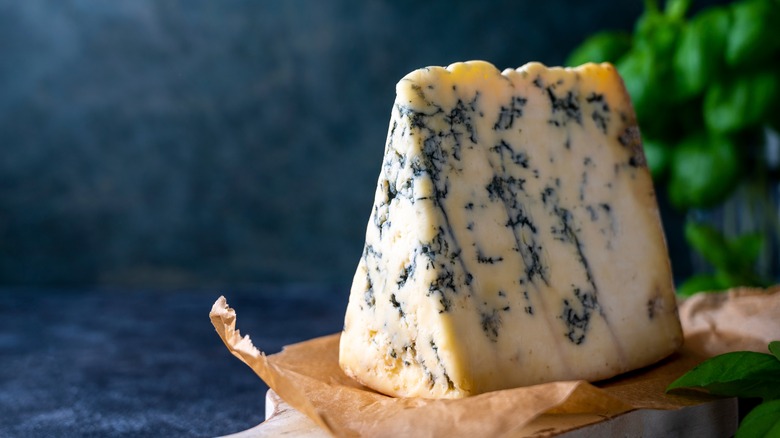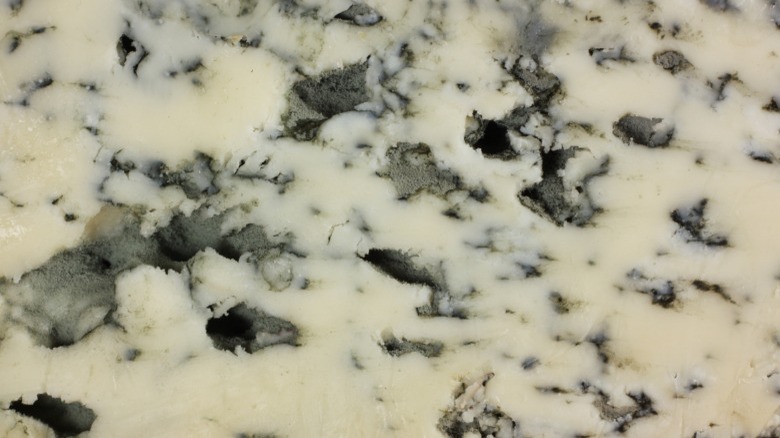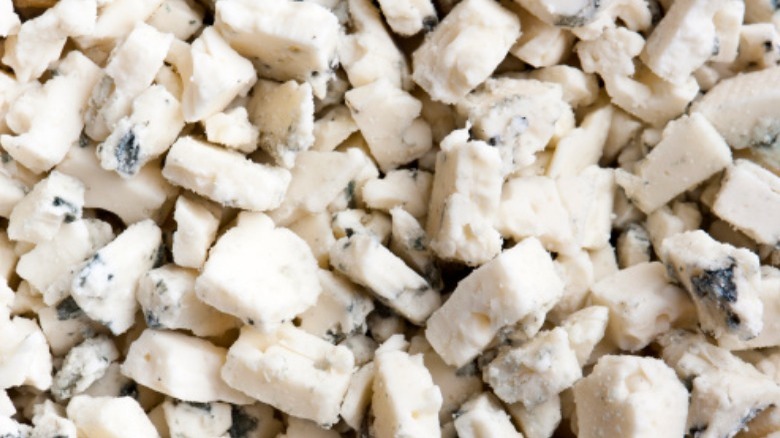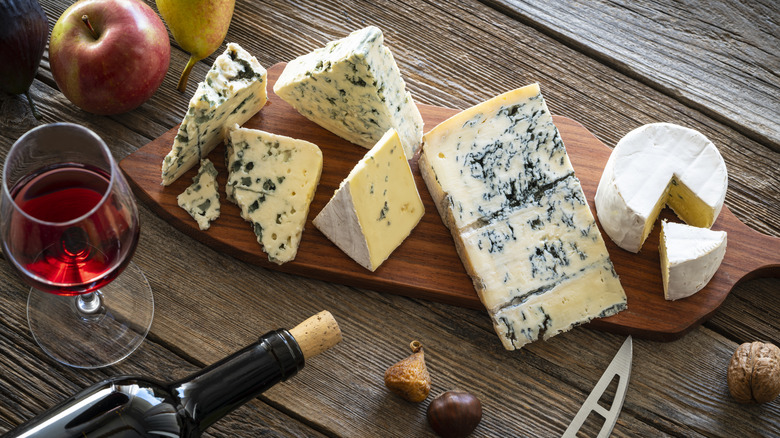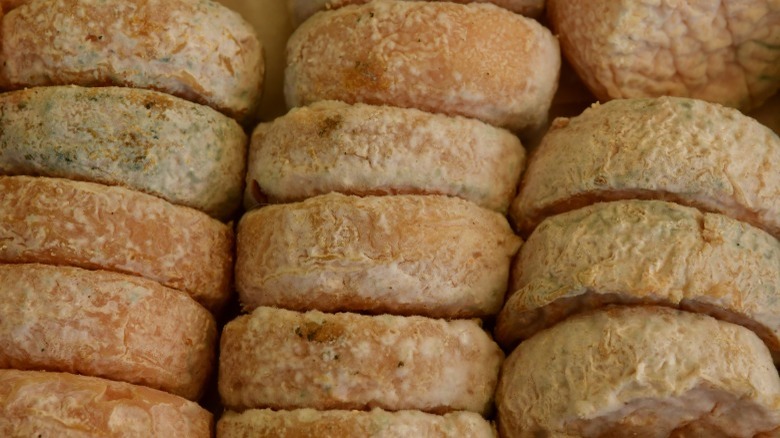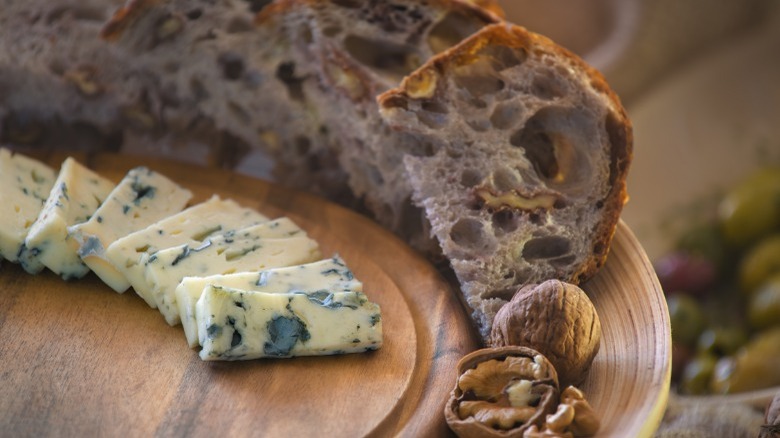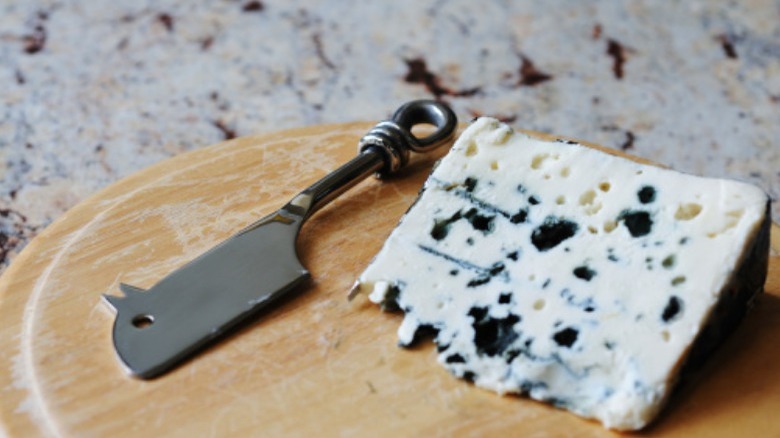There's A Blue For You: Blue Cheeses And How To Love Them
There are those of us who love the wonderful funk of blue cheese wholeheartedly, and then there are those who ... don't get it. "People are turned off by blue cheese for the simple fact that it is blue," speculates New York City-based cheese educator and consultant Michele Molier. "Other than yellow cheddars, we aren't really used to colors popping up in our cheeses, unless they're infused with truffle or other things. Also, the blue mold that appears in blue cheese is easily associated with the blue mold we find in our fridges, which immediately conjures up spoiled or nasty connotations."
Perhaps you can relate to this rationale, or perhaps your sole experience with blue cheese is as bottled salad dressing, which is ... whatever, but given the choice you'd always trade it in for the superior, garlic tang of ranch for your wings or Cobb salads. Or maybe it's just that particular, peculiar aroma of "global-ness," Molier offers, as an alternative to negatively connotative adjectives commonly associated with blue cheese.
Understanding blue cheese mold
The world of blue cheese is as far-reaching as the world of cheese itself, with varying animal milks, elements of seasonality, and cheesemaking techniques contributing to selections that come from just about every country that makes cheese, and produce outcomes of flavor and texture that can appeal to blue beginners and thrill-seekers alike. So if you feel like it could be time for a little grow-up where blue cheese is concerned, let's get to know some of its defining characteristics, and outline a few selections worth trying for the novice to the fully initiated.
First things first, the mold is not a mistake. "The main method of making blue cheese is a piercing method," explains Molier. "This is a bit of a shocker to some people because it's more easy to imagine the cheese being directly injected with blue mold. All blue cheeses start as simple-looking white wheels which are then pierced with thick, stainless steel needles [which] create crevices, then oxygen enters those crevices, and reacts with the cultures and other microbes in the cheese to start producing a mold, which begins to form as blue crumbles."
The mold itself is from one or more strains from the genus Penicillium, but contrary to popular myth, these are not the same strains that might become something you take as an antibiotic.
How blue cheese is made
Blue cheese can be made from cow's, goat's, or sheep's milk, as well as any of those being raw, or pasteurized, resulting in a wide variety of base cheeses before injection occurs. Additionally, the diets of the particular animals create variables in cheesemaking, whether they are eating summer grasses or winter hay, and whether those animals are grazing in Ireland or Ecuador, in the mountains, or by the sea.
Furthermore, the cheesemaker can affect the outcome of a given blue cheese in terms of how much Penicillium is allowed to penetrate the wheels, how the cheese is ripened and for how long, whether a rind is allowed to form, and any other treatments they wish to apply to the cheese as it develops.
There are plentiful pairing options
In October 2019, the Guild of Fine Food awarded the top prize for the tastiest curds to Rogue River Bluefrom Rogue Creamery in Central Point, Oregon. The cheese is wrapped in organic syrah leaves that have been soaked in pear liqueur to emphasize certain flavors. Outcomes of all of these variables produce blue cheeses that can be downright sweet to mildly earthy, and bright to peppery. Safe to say there's practically an infinite number of variations when it comes to what blue cheese can be.
How you approach eating blue cheese can also affect your enjoyment of it. Sweet elements such as bread, fruits, jams, syrups, and sweet wines can echo the natural sweetness of blue cheese and balance out the sharper and saltier notes, all excellent places to begin for the cautiously open-minded. Blue cheese on a burger can emphasize its rich and umami characteristics. If the wildness is what you crave, try blue cheese in a salad with equally sharp onions and peppery arugula, or pair it with a dank and juicy New England IPA.
Novices should stick to a milder blue cheese
"For a novice who doesn't think they like blue cheese," offers Molier, "get started on Bayley Hazen Blue, from Jasper Hill Farm or Persille de Rambouillet. Both of these cheeses have a super-friendly white paste that is reminiscent of ice cream or fluffy cottage cheese. Neither has aggressive blue molding and you can even eat your way around the blue—if you absolutely have to!"
If these aren't available, you can always ask your cheesemonger for other sweeter, subtler blues to begin with. Other easy-going blues include Gorgonzola dolce (Italy), St. Agur (France), Cashel Blue (Ireland), and Mycella Blue (Denmark). A top tip is to not be afraid — get inquisitive and get excited about the opportunities of what blue cheese can offer you. You're going to be pleasantly surprised, and these cheeses are a great way to begin your blue cheese journey.
There are domestic options aplenty
If you think you already have the taste for it and want to expand the blues on your palate, Molier points to California, whose creameries helped to put U.S. blue cheese-making on the world map. "Point Reyes Original Blue is a great cheese for seasoned blue cheese eater[s]. It's made with raw cow's milk, giving an extra edge to the wheel right away. Each wheel is different but there is generally a large amount of blue molding and each bite will have crumbles of peppery blue/green mold, which complements its super rich paste."
Also look for other blues that have variations on the process, many of which are made domestically where ancient food rules do not apply such as Rogue River Blue (Oregon), Big Rock Blue (California), Maytag (Iowa), and Arethusa Blue (Connecticut). International middleweights include Gorgonzola (Italy), Cambozola (Germany), and Fourme D'Ambert (France). There's no shortage of blue cheeses to try to take your experience to a new, stronger level.
For fans of the funk
Finally, for those who think they can dive into the deep blue hole: "Go Roquefort or go home," instructs Molier. "This French blue cheese sets the mold for all blue cheeses after it. It is a sheep's milk blue cheese, so you're going to get some additional body and meatiness from the milk alone. The secondary culture in this cheese is Pencillium Roqueforti, and it's this culture that gave the cheese its name. It's punchy, salty, and all-around mind-blowing. If you're enjoying this cheese on a cheese board or at a party, be sure to eat it last. You may not be able to taste anything afterwards!"
Other super strong blues include heavy hitters from England such as Stilton and Shropshire Blue. If you've made it this far, you're in for a world of some incredibly tasty — and incredibly pungent — flavors.
